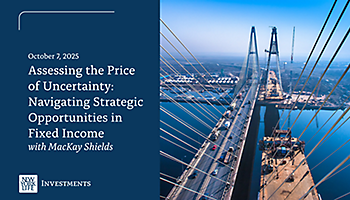
Navigate Complex Bond Markets
Bond Market Turbulence Is Real – So Is the Opportunity
Explore how our active managers seek to navigate volatility with timely perspectives across municipal, high yield, and multi-sector strategies. Your guide to positioning portfolios with purpose starts here.
2025 INVESTMENT OPPORTUNITES FROM NYLIM
Navigate Complex Bond Markets
Lorem ipsum dolor sit amet, consectetur adipiscing elit, sed do eiusmod tempor incididunt ut labore et dolore magna aliqua. Ut enim ad minim veniam, quis nostrud exercitation ullamco laboris nisi ut aliquip ex ea commodo consequat
Disclosure
1 Utilize the Entire Fixed Income Toolkit - Holdings data as of 9/30/2025. Portfolio holdings are subject to change without notice.
ABS = Asset-Backed Securities; CMBS = Commercial Mortgage-Backed Securities; RMBS = Residential Mortgage-Backed Securities.
2 A Compelling Case for Bonds in Today’s Environment – Bloomberg, ICE Data. Data as of 09/30/2025. Corporates = ICE BofA U.S. Corporate Index; High Yield = ICE BofA U.S. High Yield Index; Agency RMBS = Bloomberg U.S. Mortgage-Backed Securities (MBS) Index; CMBS = Bloomberg Non-Agency CMBS Index; ABS = ICE BofA US Asset Backed Securities (AA-BBB) Index; Emerging Markets (EM) = JP Morgan EMBI Global Diversified Index. Past performance is no guarantee of future results, which will vary. It is not possible to invest directly in an index.
3 Opportunistic When Market Conditions Change - Source: MacKay Municipal Managers, as of September 30, 2025. Chart shows change in HY allocation with change in HY Muni Spread. % HY Allocation – Percentage allocation of a portfolio towards high-yield bonds. HY Muni Spread – Difference in yield between high-yield municipal bonds and comparable US Treasury securities. It is a measure of the credit risk premium for investing in high-yield municipal bonds.
4 The Time is Right for Municipal Bonds – Source: Bloomberg as of 09/30/25. Yield is represented by yield to worst of Bloomberg Municipal Bond Index. Past performance is not indicative of future results. It is not possible to invest directly in an index.
All investments are subject to market risk, including the potential loss of principal. Past performance is not indicative of future results. Investment returns and principal value will fluctuate, and investors may experience gains or losses upon redemption.
The Sharpe Ratio is a measure of risk-adjusted return, calculated by dividing the excess return of an investment over the risk-free rate by its standard deviation. It is used to understand the return of an investment compared to its risk. A higher Sharpe Ratio indicates better risk-adjusted performance.
This material is for informational purposes only and does not constitute an offer to sell or a solicitation of an offer to buy any securities. The information provided does not consider the specific objectives or circumstances of any particular investor. Investment decisions should be made based on an investor’s objectives and circumstances and in consultation with their financial professionals.
About Risk: Funds that invest in bonds are subject to interest-rate risk and can lose principal value when interest rates rise. Bonds are also subject to credit risk which is the possibility that the bond issuer may fail to pay interest and principal in a timely manner. Investing in below investment grade securities may carry a greater risk of nonpayment of interest or principal than higher-rated bonds. Diversification cannot assure a profit or protect against loss in a declining market. The Funds may invest in derivatives which may amplify the effects of market volatility on the Fund’s Share price.
MSDIX:. Foreign securities are subject to interest rate, currency exchange
rate, economic, and political risks. These risks may be greater for emerging markets. Short positions pose a risk because they lose value as a security's price increases; therefore, the loss on a shortsale is theoretically unlimited. As a result, these funds may not be suitable for all investors. The use of leverage may increase the Fund's exposure to long equity positions and make any change in the Fund's NAV greater than it would be without the use of leverage. This could result in increased volatility of returns. Issuers of convertible securities may not be as financially strong as those issuing securities with higher credit ratings and are more vulnerable to economic changes. The principal risk of mortgage dollar rolls is that the security the Fund receives at the end of the transaction may be worth less than the security the Fund sold to the same counterparty at the beginning of the transaction. The principal risk of mortgage-related and asset-backed securities is that the underlying debt may be prepaid ahead of schedule, if interest rates fall, thereby reducing the value of the fund's investment.
MTFGX: Municipal bond risks include the ability of the issuer to repay the obligation, the relative lack of information about certain issuers, and the possibility of future tax and legislative changes, which could affect the market for and value of municipal securities. A portion of the Fund's income may be subject to state and local taxes or the alternative minimum tax. Income from municipal bonds held by the Fund could be declared taxable because of unfavorable changes in tax law, adverse interpretations by the Internal Revenue Service or state tax authorities, or noncompliant conduct of a bond issuer.
SECR: Asset-backed securities are subject to credit risk, extension risk, interest rate risk, liquidity risk and valuation risk. The impairment of the value of collateral or other assets underlying an asset backed security, such as a result of non-payment of loans or non-performance of underlying assets, may result in a reduction in the value of such asset-backed securities and losses to the Fund.
Investments in mortgage-related securities are also significantly affected by the rate of prepayments. Impairment of the underlying obligations or collateral, such as by non-payment, will reduce a mortgage-related security’s value.

Assessing the Price of Uncertainty: Navigating Strategic Opportunities in Fixed Income

SECR NYLI MacKay Securitized Income ETF Investment Idea
Navigating Complex Bond Markets

Navigating Volatility: Key Insights on Multi-Sector Bond Positioning

NYLI MacKay Strategic Muni Allocation Fund Product Snapshot

Look Beyond Core Bonds to Unlock Diversified Sources of Returns

Have a Question?
Contact us to find out how these products fit into your portfolio and learn more about our broad range of investment products and solutions.
All investments are subject to market risk, including the potential loss of principal. Past performance is not indicative of future results. Investment returns and principal value will fluctuate, and investors may experience gains or losses upon redemption.
Active management strategies typically have higher fees than passive management.
Tax-equivalent yields are used to compare taxable and tax-exempt investments. They are based on federal income tax rates and do not account for state or local taxes. Actual after-tax returns will vary based on an investor's tax situation. Investors should consult with their tax advisors to understand the implications of their investments.
The Sharpe Ratio is a measure of risk-adjusted return, calculated by dividing the excess return of an investment over the risk-free rate by its standard deviation. It is used to understand the return of an investment compared to its risk. A higher Sharpe Ratio indicates better risk-adjusted performance.
This material is for informational purposes only and does not constitute an offer to sell or a solicitation of an offer to buy any securities. The information provided does not consider the specific objectives or circumstances of any particular investor. Investment decisions should be made based on an investor’s objectives and circumstances and in consultation with their financial professionals.
The Bloomberg U.S. Aggregate Bond Index is a broad-based benchmark that measures the investment-grade, U.S. dollar-denominated, fixed-rate taxable bond market, including Treasuries, government-related and corporate securities, mortgage backed securities (agency fixed-rate and hybrid adjustable-rate mortgage pass-throughs), asset-backed securities, and commercial mortgage-backed securities. The Bloomberg U.S. Corporate Bond Index measures the investment grade, fixed-rate, taxable corporate bond market. It includes USD denominated securities publicly issued by U.S. and non-U.S. industrial, utility and financial issuers. The Bloomberg U.S. Corporate High Yield Bond Index measures the USD-denominated, high yield, fixed-rate corporate bond market. Securities are classified as high yield if the middle rating of Moody’s, Fitch and S&P is Ba1/BB+/BB+ or below. Bonds from issuers with an emerging markets country of risk, based on Bloomberg EM country definition, are excluded.The Bloomberg U.S. Mortgage Backed Securities (MBS) Index tracks fixed-rate agency mortgage backed pass-through securities guaranteed by Ginnie Mae (GNMA), Fannie Mae (FNMA), and Freddie Mac (FHLMC). The index is constructed by grouping individual TBA-deliverable MBS pools into aggregates or generics based on program, coupon and vintage. The Bloomberg Non-Agency Investment Grade CMBS index tracks the market for non-agency commercial mortgage-backed securities in the United States. The index includes non-agency CMBS conduit and fusion deals with a minimum size of $300 million. The ICE BOfA AA-BBB U.S. Fixed Rate Asset Backed Index tracks the performance of U.S. dollar denominated investment grade fixed rate asset backed securities publicly issued in the U.S. domestic market rated AA1 through BBB3, inclusive. The J.P. Morgan EMBI Global Diversified Index tracks USD-denominated bonds issued by sovereign and quasi-sovereign entities from emerging market countries. The index caps individual country weights at maximum exposure limits of 10% and redistributes the excess weight to smaller countries to avoid concentration risk. The ICE U.S. Fixed Rate Non-Agency CMBS Index tracks the performance of U.S. dollar denominated investment grade fixed rate non-Agency commercial mortgage backed securities publicly issued in the U.S. domestic mark


